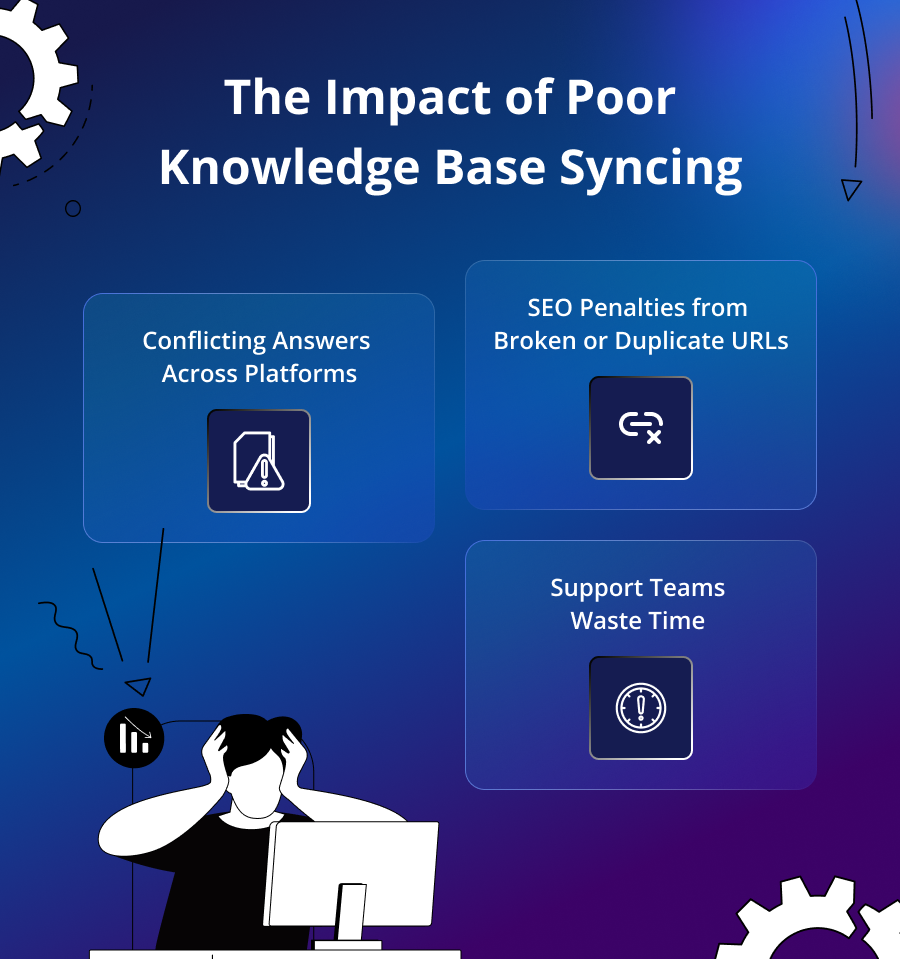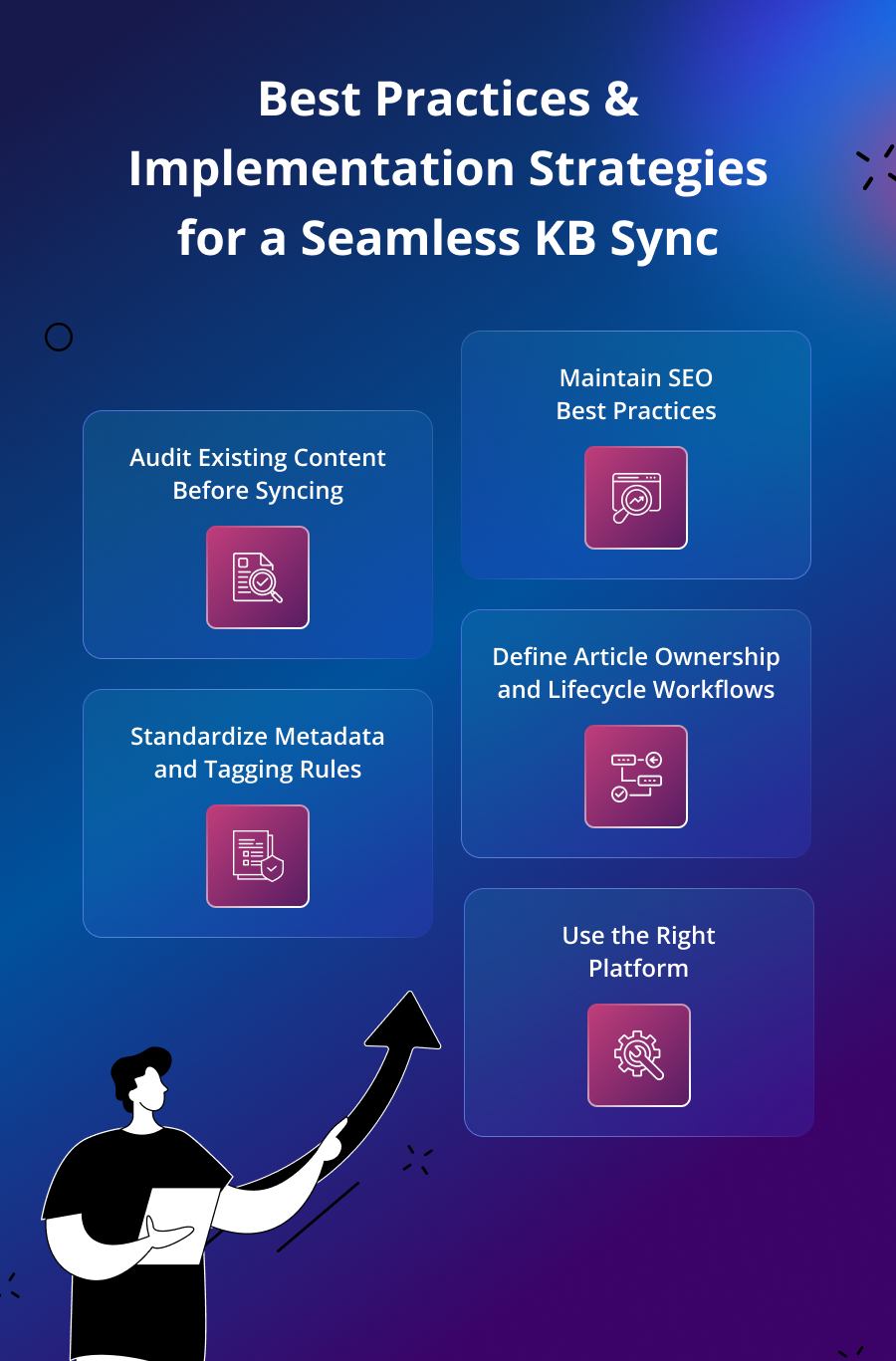Overcome Challenges in Syncing Knowledge Base Articles Without Losing Structure & SEO
When it comes to providing healthy customer support, maintaining a well-organized and up-to-date knowledge base is crucial. It’s a living, breathing asset that powers self-service, fuels search traffic, and equips support teams with consistent answers.
However, as organizations scale and adopt multiple platforms such as support portals, online communities, and customer success hubs, knowledge base content often becomes fragmented and difficult to manage. That’s where knowledge base integration becomes essential.
However, when syncing is done poorly, it causes more harm than good – broken links, outdated content, SEO penalties, and wasted support effort. This has a direct impact on the customer support experience, eroding customer trust and increasing ticket volume.
To prevent this, organizations need a clear strategy for knowledge base sync, one that supports SEO-safe knowledge base migration, content consistency, and governance at scale.
TL;DR:
- A scattered knowledge base hurts SEO, support efficiency, and customer trust
- Common sync methods often create more problems than they solve
- The fix lies in a smarter approach & implementation strategies: audit, standardize, govern, and automate
- With the right tool, you can turn KB sync chaos into a seamless, SEO-safe support experience
Understanding Why a Unified Knowledge Base Matters More Than Ever
A unified knowledge base is more than just content management; it’s the backbone of consistent, scalable support. Here’s what you gain when it’s done right:
- Improved Self-Service: When customers can reliably find accurate, consistent answers across every touchpoint, they’re more likely to resolve issues on their own, without needing to contact support. This reduces tickets and boosts satisfaction.
- Protects Organic Traffic: Search engines love well-structured, consistent content. A unified, properly synced KB avoids duplicate content, strengthens domain authority, and ensures only the right pages get indexed. This preserves SEO health.
- Enhances Cross-Team Efficiency: Support, product, and marketing teams all rely on KB content. When that content is centralized and aligned, onboarding improves, collaboration flows smoothly, and internal communication improves.
- Stronger Customer Trust: A unified KB builds customer trust & confidence by providing consistent, up-to-date content across all touch points.
But maintaining a unified KB is not always easy. Challenges arise when organizations scale & KB articles scatter due to poor synchronization. Let’s take a look at the effects of poor KB migration.
The Impact of Poor Knowledge Base Syncing

- Conflicting Answers Across Platforms: If a customer finds two different answers, one on your support portal and another in your online community, they lose confidence and open a ticket. Your agents lose time clarifying instead of resolving issues.
- SEO Penalties from Broken or Duplicate URLs: Multiple versions of the same article or outdated links that now display a 404 error slowly erode your domain authority. Google penalizes duplicate content, and you unknowingly dilute your organic reach over time.
- Support Teams Waste Time: When KB articles are misaligned, agents spend unnecessary time sorting through outdated or conflicting content, increasing resolution time, all while reducing motivation.
So, what causes all these issues in the first place? In many cases, these issues often stem from outdated tools and manual syncing processes that can’t keep up with the complexity.
Understanding Why Traditional Sync & Migration Methods Fail?
- Manual Migrations: Relying on manual, copy-paste updates leads to inevitable inconsistencies. One missed update can cascade into conflicts across platforms, especially when managing support portal article sync alongside community hubs.
- Tech Limitations: Legacy systems still rely on basic CSV-based exports and imports that fail to preserve rich formatting. Tables break. Images disappear. Hyperlinks stop working. Attachments go missing. This strips your content of its usability and credibility, affecting both internal teams and end users who depend on clear, actionable articles.
- No Governance: Without version control for knowledge base content, it’s impossible to track ownership or edits. You are left in limbo – trying to figure out who changed what. This lack of governance leads to confusion, duplicated effort, and overall content chaos.
- SEO Damage: Unmanaged syncs create duplicate pages, broken URLs, and inconsistent metadata, confusing both search engines and users. Over time, these issues drag down your search rankings, reduce organic traffic, and fragment your content’s visibility.
If you’re facing these issues, it’s time to adopt modern strategies and tools designed for community support integration and automated knowledge base syncing.
Best Practices & Implementation Strategies for a Seamless KB Sync
A successful KB sync requires more than just automation. It demands strategic planning and alignment across teams. Mentioned below are the best practices & implementation strategies to ensure efficiency, consistency, and content integrity:

- Audit Existing Content Before Syncing: Before initiating any sync, evaluate the current state of your KB. Identify outdated, duplicate, or irrelevant articles. This ensures only high-quality, relevant content is migrated, saving time and reducing clutter.
- Standardize Metadata and Tagging Rules: Inconsistent metadata can break your KB structure post-sync. Define clear rules for categories, tags, and metadata fields to ensure content is well-organized and easily searchable across platforms.
- Maintain SEO Best Practices: SEO should not be an afterthought. Retain original URLs where possible, implement proper redirects for any changes, and keep title tags, meta descriptions, and internal links intact to preserve organic visibility and rankings.
- Define Article Ownership and Lifecycle Workflows: After the sync, make sure every article has a clear owner responsible for keeping it accurate. Set up simple workflows for regular reviews, content updates, and clean-up. This ensures your KB stays relevant, reliable, and easy to trust.
- Use the Right Platform: Ensure your KB stays consistent, accurate, and optimized across platforms by using the right technology. Look for features like real-time syncing, metadata preservation, and version control. A tool like KaseSync brings all of this together, making the sync process seamless and reliable.
Why KaseSync is Built for Seamless Knowledge Base Integration?
KaseSync is a purpose-built, community support integration solution that takes the complexity out of knowledge base syncing through KB Sync. It ensures your articles stay consistent, SEO-safe, and properly structured across platforms, without manual rework. Designed to support a growing content ecosystem, KaseSync helps teams maintain accuracy, reduce duplication, and deliver a unified knowledge experience.
Key Capabilities of KaseSync
- Real-Time Syncing: Automatically pushes article updates across all connected platforms the moment changes are made. There are no delays & no duplicate work. This ensures users always access the current version, regardless of where they engage with your KB.
- SEO Protection: Retains original URLs and prevents duplicate content issues that can hurt search rankings. Your KB stays optimized for organic traffic even as content evolves or moves.
- Metadata Mapping: Maintains structured data integrity by accurately syncing categories, tags, permissions, and article statuses across systems. This keeps your content organized, searchable, and aligned with governance standards.
- Version Control: Eliminates confusion caused by conflicting edits or outdated versions. KaseSync ensures only the latest, approved version of an article is displayed, no matter where it’s accessed.
- Support Efficiency: Improves accuracy and consistency across all support channels, helping teams resolve queries faster and reduce content-related friction.
Real-World Example of KaseSync in Action
A global hi-tech company was facing issues with a fragmented knowledge base that resulted in low engagement rates and high case volume. Manual updates further led to duplicate articles, formatting issues, and inconsistent customer experience.
With KaseSync’s KB Sync, they automated KB syncing across all platforms like Salesforce & Higher Logic Vanilla. This protected content integrity, SEO performance & reduced support costs.
Meaningful Results Achieved
- 100% Metadata Retention
- 42% Increase in Case Deflection
- 30% Reduction in Support Costs
Wrapping Up
Knowledge base syncing and migration are essential for delivering scalable, SEO-friendly, and trustworthy support. Without a clear strategy and the right tool, organizations risk broken links, duplicate content, and poor support outcomes.
By adopting best practices and leveraging an automated knowledge base syncing tool for Salesforce, like KaseSync, you can enable community support integration and unify content across portals, ensuring long-term SEO health, all while strengthening your customer support experience.
FAQs
- Why does improper knowledge base sync affect SEO?
Improper knowledge base syncing can lead to duplicate articles, broken URLs, and inconsistent metadata. These issues confuse search engines, dilute rankings, and gradually erode your site’s organic visibility. - What are the biggest risks of manual knowledge base migration?
Manual migrations often lead to missed updates, broken formatting, lost attachments, and version conflicts. These not only hurt SEO but also confuse customers and support teams. - What are the best practices to follow before syncing the knowledge base?
Begin with a thorough audit of your knowledge base to clean out outdated or duplicate articles. Next, align metadata and tagging rules, and assign clear ownership for each article. These steps ensure your content stays accurate, consistent, and reliable after syncing. - How does KaseSync help with SEO-safe knowledge base syncing?
KaseSync automates article updates in real time, preserves URLs and metadata, prevents duplicate content, and provides version control. This ensures your KB stays accurate, unified, and optimized for search engines.










